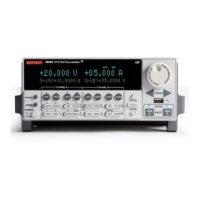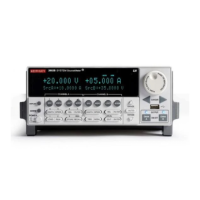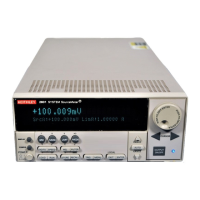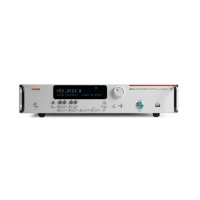2600S-901-01 Rev. C / January 2008 Return to Section Topics 12-5
Series 2600 System SourceMeter® Instruments Reference Manual Section 12: Instrument Control Library
Logical instruments
You would normally refer to all instrumentation within one enclosure or node as a single
instrument. For TSP and Instrument command library (ICL)., it is useful to think of individual SMUs
as instruments. To avoid confusion, SMUs and other subdivisions of the instrumentation within an
enclosure will be referred to as “logical instruments.”
Each logical instrument is given a unique identifier in a system. These identifiers are used as part
of all ICL function calls that control a given logical instrument. A Series 2600 SMU has the
following logical instruments per enclosure:
beeper errorqueue smua status
digio gpib smub tsplink
display serial timer
Logical instruments also look like TSP tables. In addition to the logical-instrument-specific
attributes and the commands to which they respond, there are a few attributes that provide
information about the logical instrument. These attributes are listed below:
name A string that represents the logical instrument’s name. For example, smua.
node A reference to the TSP-Link node of which the logical instrument is a part.
Each logical instrument has an element for each command that it supports. These commands are
documented in this section. Note that
smua and smub support the same command set and are
documented jointly as
smuX.
On any given node, the logical instrument identifiers from that node are also global variables. They
can be accessed as elements of the node they belong or directly if running on that node. For
example, to execute the
measure.v command on smua on node[5], one could use
node[5].smua.measure.v(). If the command is being issued (executed) on node[5], then
smua.measure.v() is sufficient. Only be concerned with node numbers when controlling multiple
units via the TSP-Link.
Reading buffers
Readings can be obtained in multiple ways. Reading acquisition can be synchronous or
overlapped. Furthermore, the routines that make single point measurements can be configured to
make multiple measurements where only one would ordinarily be made. Also, consider that the
measured value is not the only component of a reading. The measurement status (e.g. “In
Compliance” or “Over ranged”) is also data associated with a particular reading.
All routines that return measurements can return them as reading buffers. Overlapped
measurements are always returned in a reading buffer. Synchronous measurements return a
single value or both a single value and a reading buffer. The more advanced user can use the
reading buffer to access the additional information stored in the reading buffer.
A reading buffer is based on a TSL table. The measurements themselves are accessed by
ordinary array access. If
rb is a reading buffer, the first measurement is accessed as rb[1] and
the 9
th
measurement as rb[9], etc. The additional information in the table is accessed as
additional members of the table. The following values are all available per reading buffer, i.e.,
rb.appendmode:
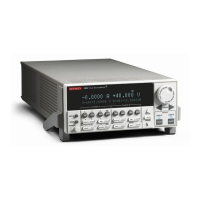
